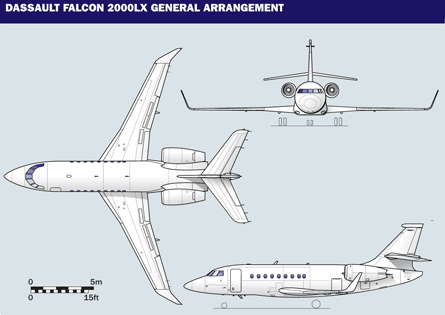Dassault is updating its business jets. Its API winglet-equipped Falcon 2000LX, announced at the EBACE business aviation show in 2007 and recently certificated in Europe and the USA, was joined in 2008 by the Falcon 900LX, equipped with the same winglets.
Developed from the Falcon 2000EX, the LX retains the same advanced Dassault/Honeywell EASy cockpit and Pratt & Whitney Canada PW308C engines. The twinjet will become the production standard in 2010.
In the meantime, customers who have ordered a 2000EX can have the winglets retrofitted by Dassault so the aircraft is delivered as a 2000LX. Owners of Falcon 2000 or 2000EX aircraft can have the winglets retrofitted by API in the USA or in Europe.
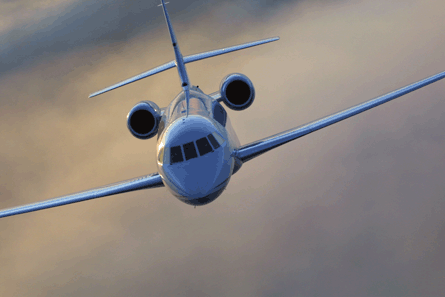 |
|---|
© Dassault |
Fully blended, the carbonfibre winglets curve to the vertical 1.7m (5.5ft) above the wing surface and increase the (effective) wing span by a little over 2m on each side. They and the simple wing reinforcement required, mean that the total weight increase for the aircraft is only 113kg (250lb) - 36kg for the winglets and 77kg for the reinforcement.
The joint Dassault/API design and certification programme has proved the aerodynamic and load optimisation of the winglets to give best performance. The aircraft retains the 2000EX maximum take-off weight of 19,160kg and has been able to keep its maximum landing weight of 17,840kg.
NO FLIGHTDECK CHANGE
Significantly, the winglets require no flightdeck change, are fully lightning strike protected, show no performance degradation due to flight in icing conditions, are fully retrofit capable, and are designed for maximum damage tolerance. Furthermore, the aircraft is certificated for ferry flight with one winglet missing.
The 2000LX retains the same generous 2.3m-wide, 8m-long cabin as the 2000EX, with the same luxurious eight or 10 executive-seat option. The balanced field length at MTOW is unchanged at 1,790m (so 2000EX performance manuals do not need to be reissued) and the landing distance is increased only slightly to 800m at destination from an approach indicated airspeed of only 113kt (209km/h). VMO/MMO is 370kt/Mach 0.86. The payload remaining at the maximum fuel load is 1,030kg.
 |
|---|
© Dassault |
Impressive as the winglet design, engineering and wing integration features are, the performance gains granted to the 2000LX are stunning. The aircraft now has a maximum range of 7,400km (4,000nm) at M0.8, still air, with six passengers and two crew at NBAA IFR reserves, making it a truly intercontinental aircraft with city pairs such as Geneva-New York, Geneva-Mumbai and Dubai-Shanghai now achievable without refuelling.
Compared with the EX, the winglets provide the 2000LX with a 5% increase in range, a 5% decrease in fuel if used over the same (shorter) range and improvement in climb performance ranging from 10% in ISA conditions to 15% in hot conditions).
This climb performance now allows the 2000LX, at MTOW, to climb directly to an initial cruise altitude of 41,000ft in just 19min and convert that, after about 4h of cruise from a MTOW condition, to a final cruise altitude of 45,000ft.
Added to this outstanding climb, cruise and range performance combination, Dassault says the 2000LX is 30-75% more fuel efficient than any of its closest competitors (the Bombardier Challenger 605 and Gulfstream G350 and G450) in the same configuration. To put this into perspective, on a non-stop flight from New York to Rome, with fuel at $1.6/litre ($6/USgal), a 2000LX will save the owner in the region of $10,000, in just one flight.
Fuel efficiency will also be a major factor in classifying the 2000LX with the lowest carbon emissions in its competing group. Future "green taxes" on aircraft are likely to add to direct operating costs of business aviation, so the carbon tax rating of an aircraft will probably become just as important as the fuel price.
ASSESSMENT
My goal was to take a "quick look" test evaluation of the 2000LX to see if the winglet additions had made any difference to the aircraft's handling, especially in the lateral and direction axes (roll and yaw).
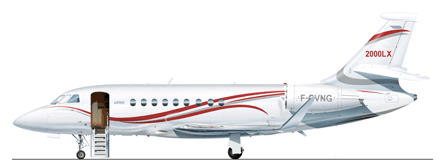 |
|---|
|
|---|
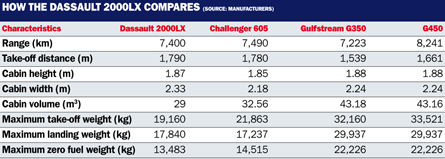 |
The aircraft retains the same 30kt landing crosswind limit as the 2000EX and the only flight control system changes for the 2000LX were to droop both ailerons by 1.5° and to alter the pitch (elevator) artificial feel unit slightly as the winglets give the aircraft more pitch stability.
We flew from Istres near Marseilles, using the Falcon 2000 engineering prototype (F-WXEY) fitted with the production winglets and recently returned from the USA at the end of the joint certification programme. My safety pilot was Dassault chief test pilot Philippe Deleume. Basic operating weight (with a crew of four) was 10,475kg, plus 2,720kg of fuel, giving a weight at start-up of 13,195kg.
On walk-out, my first impression of the winglets were not only their vertical size but how beautifully blended they were to the wing. After boarding into the left-hand cockpit seat, the EASy avionics were programmed (it continues to be my favourite electronic flight information system cockpit and the best cockpit man-machine interface that I have operated). I would fly the complete sortie, with Deleume handling the radio telephony/air traffic control.
Take-off was with slats/flaps 2, giving a VR (rotate speed) of 110kt. After take-off we briefly levelled at 1,500ft at an indicated airspeed of 250kt, with the throttles almost back at idle. When cleared by air traffic control, we climbed directly to flight level 410 at 260kt/M0.75. Early sustained climb rate passing 10,000ft was almost 7,000ft/min (35.5m/s). From 1,500ft to FL410 took just 10min.
LATERAL CONTROLS
During the climb I could assess the lateral controls (the 2000LX rolls only with ailerons). Roll control instantly felt powerful with very light forces, very sensitive and beautifully harmonised in terms of force ratios allied to the pitch and yaw axes.
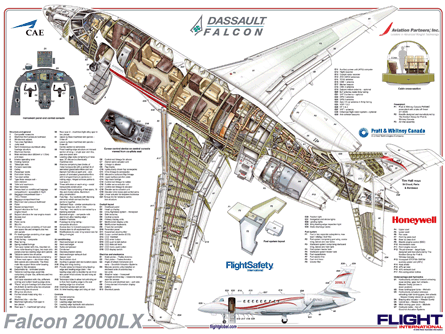 |
|---|
Click on cutaway for full size version |
The control mechanical characteristics (yoke) showed no freeplay, had very accurate centring and a very small breakout force required to start the roll rate.
Sustained maximum roll rate was 50-60° and that rate did not seem to alter as altitude increased. Once again, Dassault's expertise in flight-control design was highly evident and its marketing claim about the "read across" from its military fighter aircraft to its business jets clearly is an engineering reality.
At FL410 we conducted 45°, then 60° angle of bank turns without fuss. Pulling a little harder beyond 60° angle of bank to 2.1-2.2g only induced a very light wing buffet with no indication of wing rock. Spiral stability was neutral. Dutch roll was positively damped (with yaw damper disengaged).
The aircraft rolled with rudder, without hesitation, in the same direction of the applied pedal. The high flight-level lateral/directional handling characteristics of the aircraft were faultless.
A high-speed simulated "emergency descent" was then flown at M0.85/370kt with throttles idle, airbrake position two (maximum) and with aircraft pitch around 25° nose down. The aircraft was held in a tight 70° angle of bank turn and we levelled at FL150 with ease.
At FL150 and at a VA of 190kt, full deflection lateral inputs gave a roll rate of 55-60°/s but the Q feel had increased the roll control forces slightly to ensure the roll rate was not excessive.
A very small adverse yaw was evident at full aileron deflection, but was almost instantly corrected by the fin, without directional overshoot, on roll-out. Roll control at approach to stall was highly effective and without problem irrespective of aircraft configuration or reference speeds.
An instrument landing system recovery to Istres (flown manually) showed that I was able to track the flight director with almost effortless ease and absolute precision for the required small bank angles and heading changes. The 2000LX shows none of the roll "notching" that sometimes accompanies aircraft that also have spoilers for lateral control or that have any amount of lateral control yoke freeplay.
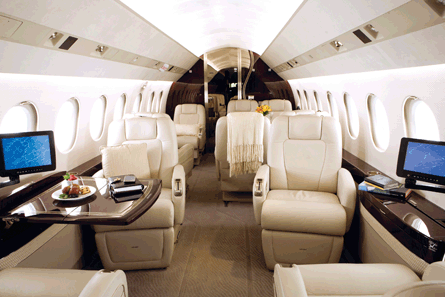 |
|---|
© Dassault |
Two visual circuits were then flown aggressively on to a very "close" downwind leg at 1,000ft above ground level and a very tight finals turn, including a late finals lateral offset manoeuvre (at about 200ft above ground level) to simulate a threshold capture from a poorly executed instrument approach when arriving at decision height.
The 2000LX flew like a well-behaved fighter aircraft and it was a delight to fly it. I simply could not fault the business jet in any handling regime.
CONCLUSION
I left Istres in awe of what the Falcon 2000LX represented. The combination of take-off, landing, climb and cruise performance, flexibility of operation, comfort, size of cabin, impeccable "fighter-like" handling characteristics, advanced cockpit avionics systems and simply staggering range/fuel efficiency figures now makes the 2000LX the worldwide benchmark in this class of business jet.
Other present or future competitors will have to work very hard to match it. The 2000LX Dassault/API winglet integration is faultless.
If "perfoenvironomics" can be the new buzzword for 21st century aerospace, then the Falcon 2000LX is an aircraft that now perfectly encapsulates that concept.
Source: Flight International





















